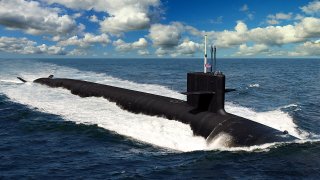The U.S. Navy's Columbia-Class Submarines Face a New Problem
The U.S. Navy's new Columbia-class ballistic missile submarine, a key element of U.S. nuclear deterrence, is facing delays.
That Sinking Sub Feeling: The U.S. Navy's new Columbia-class ballistic missile submarine, a key element of U.S. nuclear deterrence, is facing delays.
Problems for Columbia-Class: Originally scheduled for delivery in Fiscal Year 2027, the timeline has now shifted to Fiscal Year 2028 due to manufacturing delays, particularly with the bow module and steam turbines.
Bottomline: The Columbia class is set to replace Ohio-class submarines on a one-to-one basis, making timely delivery critical to maintaining the Navy's strategic deterrence capabilities. Any further delays could risk reducing the Navy's ability to meet its deterrence requirements.
Columbia-Class Submarine Delays: A Threat to U.S. Nuclear Deterrence?
The U.S. Navy’s new ballistic missile submarine is facing delays, as multi-billion dollar weapons projects often seem to do. The Columbia class, the Navy’s number one procurement priority, is a critical component of U.S. nuclear strategy, and delays could cause a gap in deterrence coverage.
The Columbia class, originally scheduled to start arriving in Fiscal Year 2027, could be delayed until Fiscal Year 2028.
“The largest hurdle for District of Columbia is the bow module of the submarine that is under construction at HII’s Newport News Shipbuilding in Virginia,” USNI News reported. “The overall program is facing additional delays from the steam turbines that Northrop Grumman is under contract to build for the Navy.”
Building the Columbia-Class
The Columbia class is being built in different segments and at different locations. The vessel’s central barrel, for example, is being constructed in Groton, Connecticut and in Quonset Point, Rhode Island, under the supervision of General Dynamics Electric Boat. The central barrel is to be married to the bow and stern sections, which are under construction down I-95 in Virginia.
The stern was delivered in January, but the bow has been delayed. Manufacturing delays have snagged steam turbine production, too.
“We’re seeing stress across the industrial base and again I think putting this in the context of the Secretary’s 45-day review will add additional depth and context to the challenges that we’re seeing across the shipbuilding portfolio and we expect to have that done fairly soon,” Under Secretary of the Navy Erik Raven told USNI.
Not a Surprise on Columbia-Class Submarine Delay
The delay of the Columbia class’s lead ship is not exactly a surprise. Delays in new weapons programs are practically a rule of thumb. Developing a system as complex as a nuclear-powered ballistic missile submarine is a daunting venture, with immensely consequential variables at play. Any number of snags can derail a program’s delivery timeline.
“Columbia started out on an accelerated schedule,” Chief of Naval Operations Adm. Lisa Franchetti said. “We are no longer on the accelerated schedule, but we are meeting the contracted delivery schedule for Columbia.”
That’s a clever way of saying they are not behind – they were ahead of schedule, and now are merely on schedule.
Franchetti continued: “We are continuing to work closely with industry against all those challenges that I described earlier and continuing to provide the right level of oversight so we understand where we are. It is [an] all hands on deck effort to ensure that we stay on time.”
One-for-One Replacements
There is a lot of pressure to deliver this system, because the Columbia class is scheduled to replace Ohio-class ballistic missile submarines on a one-to-one basis. For every Ohio-class vessel that is retired, a Columbia-class submarine is supposed to commission. That will maintain U.S. deterrence capabilities at preferred levels.
Under current requirements, the Navy is expected to be able to surge 10 ballistic missile subs in the event of a nuclear contingency. Right now, there are 14 ballistic missile submarines in the Navy’s fleet. So the margins for being able to hit the 10-submarine requirement are low – any retired Ohio-class without a replacement would reduce the margins further.
About the Author: Defense Expert Harrison Kass
Harrison Kass is a defense and national security writer with over 1,000 total pieces on issues involving global affairs. An attorney, pilot, guitarist, and minor pro hockey player, Harrison joined the US Air Force as a Pilot Trainee but was medically discharged. Harrison holds a BA from Lake Forest College, a JD from the University of Oregon, and an MA from New York University. Harrison listens to Dokken.
Image Credit: Creative Commons.

